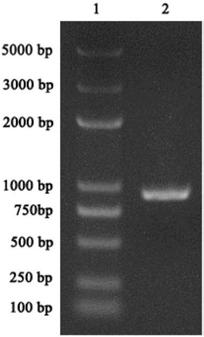Polysaccharide cracking monooxygenase LPMO 9D coding gene and enzyme and preparation and application thereof
A technology of monooxygenase and coding gene, which is applied in application, genetic engineering, oxidoreductase, etc., and can solve the problems of low degradation efficiency, easy loss of vitality, and high cost
- Summary
- Abstract
- Description
- Claims
- Application Information
AI Technical Summary
Problems solved by technology
Method used
Image
Examples
Embodiment 1
[0029] Example 1 Polysaccharide cleavage monooxygenase full-length gene cloning
[0030] Extract the RNA of the Myceliophthora thermophila strain Thermothelomyces thermophila ATCC 42464 according to the operation steps of the fungal RNA extraction kit (Shanghai Shenggong, SK8659), and follow the operation of the cDNA first-strand synthesis kit (Code NO.: 6210A) of TaKaRa Biological Company Steps to synthesize cDNA. Primers were designed according to the nucleotide sequence of the target gene, upstream primer 5'-GACC1TCGAGAAAAGACACTACATTCTTTCAGCAGCTG-3', downstream primer: 5'-CTACAAGCACTGGCTGTAGTAGTC-3'. Using the synthesized cDNA as a template, PCR amplification was performed using the PrimerStar HS DNA polymerase kit (Code No.: R010A) from TaKaRa Biological Company. The PCR reaction conditions were: pre-denaturation at 98°C for 2 min, denaturation at 98°C for 10 s, annealing at 55°C for 5 s, extension at 72°C for 1 min, a total of 30 cycles, and extension at 72°C for 5 min. ...
Embodiment 2
[0031]Example 2 Polysaccharide Cleavage Monooxygenase Gene Sequence Analysis
[0032] The sequencing results were analyzed using Basic Local Alignment Search Tool (BLAST) in the GenBank database, DNAMAN software was used for multiple sequence alignment, and VectorNTI 8.0 was used to analyze the sequence information. The coding region of the obtained polysaccharide cleavage monooxygenase gene (named lpmo 9D) is 912 bp long, and its nucleotide sequence is shown in SEQ ID NO.1. lpmo 9D encodes 303 amino acids and 1 stop codon. Its amino acid sequence is shown in SEQ ID NO.2. The theoretical molecular weight of the protein is 31.53kDa, and its predicted isoelectric point is 6.16. SignalP analysis showed that the 1-20 positions in the amino acid sequence of LPMO 9D were signal peptides. The domain characteristics of LPMO 9D are more similar to members of the AA9 family, which indicates that LPMO 9D is a new member of the AA9 family. Using the SWISS-MODEL homology modeling server ...
Embodiment 3
[0054] Recombinant expression of embodiment 3lpmo 9D gene in Pichia pastoris
[0055] Using the genomic DNA of Myceliophthora thermophila cDNA as a template, use the designed upstream primer (5'-GACC1TCGAGAAAAGACACTACATCTTTCAGCAGCTG-3', downstream primer: 5'-CTACAAGCACTGGCTGTAGTAGTC-3'.) to amplify the polysaccharide cleavage code according to the procedure in Example 1 The gene sequence of the mature protein of the monooxygenase (excluding the signal peptide gene). The PCR amplification product and the expression vector pPICZαA (Novagen, USA) were ligated by T4 DNA ligase, and the ligated product was transformed into Escherichia coli TOP10 competent cells, and spread on the solid of low-salt Luria-Bertani medium containing 100 μg / mL bleomycin On the plate, culture at 37°C for 12-16 hours, pick a single clone, and use the upstream and downstream primers for colony PCR verification, and the result is an amplified product of the correct size; insert the correct single clone into...
PUM
| Property | Measurement | Unit |
|---|---|---|
| Theoretical molecular weight | aaaaa | aaaaa |
Abstract
Description
Claims
Application Information
 Login to View More
Login to View More - R&D
- Intellectual Property
- Life Sciences
- Materials
- Tech Scout
- Unparalleled Data Quality
- Higher Quality Content
- 60% Fewer Hallucinations
Browse by: Latest US Patents, China's latest patents, Technical Efficacy Thesaurus, Application Domain, Technology Topic, Popular Technical Reports.
© 2025 PatSnap. All rights reserved.Legal|Privacy policy|Modern Slavery Act Transparency Statement|Sitemap|About US| Contact US: help@patsnap.com



